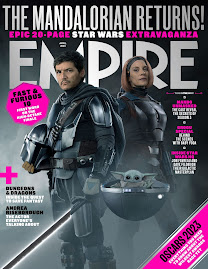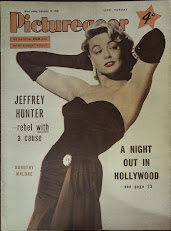Friday, March 31, 2023
Thursday, March 30, 2023
Generic research: inspiration and intial ideas
For the next stage of development, I brainstormed some of my favourite films/ cinematography to get a better idea of the inspiration I will take and potential ideas for genre, lighting, composition etc.
From this, I came up with more specific ideas to brainstorm in more detail, taking inspiration from movies in the specified genre, photography ideas, and how I would apply them to my magazine front covers/ contents pages.
Monday, March 20, 2023
Audience Research
Wednesday, March 15, 2023
Industrial Context: Contemporary Context
The major players in the consumer magazine industry in the UK are Bauer Media, Immmediate Media Company and Future Plc, which controlled an estimated 37% of circulation in 2020.
The top publishers make up a number of household names. For example, Bauer's biggest titles include TV Choice (average monthly circulation of 1.04 million), Take a Break (380, 000) and Yours (180, 000). Some of Immediate Media Co.'s biggest consumer titles include Radio Times (480, 000), English Heritage Members Magazine (450, 000) and BBC Gardeners' World (220, 000).Monday, March 13, 2023
Industrial context: Bauer as a brand
Empire is a British monthly film magazine first established in 1989, and it is one of the UK's best-selling film magazines. Its first issue featured Dennis Quaid and Winona Ryder from the film Great Balls of Fire! (1989), and sold over 50, 000 copies. Over the years, Empire has had eleven editors, and is currently edited by Sam Mendes. Empire reviews both mainstream and art films, and a regular feature ever
since the Robert De Niro film Raging Bull (1980) featured in May 2003, is the Empire Masterpiece. It is a two-page essay on a film selected by Empire in the Re. View section. The films selected are quite random and don't follow a specific pattern, but L.A. Confidential (1997) and Magnolia (1999) have both featured twice. There have been many special editions, including The Directors Collection, which, in 2001, was on Steven Spielberg. As part of its 18th birthday issue published in June 2007, Empire published a list of top 18-rated moments in film. They also selected the 50 greatest films rated with an 18-certificate.
Empire occassionally invite readers to take part in a poll to find out what their favourite films are. In September 2001, readers voted Star Wars (1977) as the greatest movie of all time, but in March 2006, The Shawshank Redemption (1994) was chosen as reader's favourite. In September 2008, a list was selected by over 10, 000 Empire readers, 150 film-makers
and 50 critics of the 500 greatest films of all time. Francis Ford-Coppola's The Godfather (1972) unsurprisingly came out on top, and Steven Spielberg was the list's most represented director, with 11 films in the top 500. However, another reader's poll in July 2014 of the 301 greatest movies of all time saw The Empire Strikes Back (1980) top the list. In 2021, they combined reader votes with Empire critics' choices to create a list of the top 100 movies, which was topped by The Lord of the Rings: The Fellowship of the Ring (2001). In 2008, a poll was conducted to ceate a list of the top 100 greatest movie characters, with Brad Pitt's Tyler Durden from Fight Club (1999) coming out on top, but, in June 2015, Indiana Jones was named the greatest film character of all time.
- Consistent, simple masthead which can vary in colour or opacity depending on the colour scheme of the issue
- The magazine's name is instantly recognisable, so large portions of it can be hidden behind an image and audiences will still recognise it
- Usually only one image on the front cover - always brightly coloured and attractive
- Images can vary from being one character/ actor to an ensemble
- Shot type of main image can vary from a close up to a long shot
- Often feature a brightly coloured puff
- Colour scheme and font types always relate to the main film they are covering - every edition is very different - attracts a larger audience
- Always feature several plugs to indicate lots more content inside.
Sunday, March 12, 2023
Industrial Context: History of Magazines
One of the first film magazines was Moving Picture World, which was established in 1907, but the first film fan magazine was established in 1911 by J Stuart Blackton, the head of Vitagraph Studios. The first fan title, The Motion Picture Story Magazine combined short-story adaptations of popular films as well as advice on how to break into the film business and profiles of stars. The magazine was a hit, and in 1914 its name was shortened to Motion Picture Magazine, and it continued to be published until 1977.
The most popular film magazine, however, was Photoplay. Photoplay was established in the same year and gained an edge over its rival by balancing studio tie-ins and an "independent" editorial voice. They were given access to sets and stars, but at the same time spoke to fans through their campaigning editorials. This edition was released in October 1920, featuring Mary Pickford on the front cover.Wednesday, March 8, 2023
NEA - Chosen Brief: Magazine and Online
For the NEA, I am most interested in Brief 3: Magazines and Online. This is largely due to the fact that I would be producing the front cover and contents pages of two new editions of a film magazine, as outside of school I am very passionate about films, and I regularly try to watch a variety of both new and old in order to broaden my knowledge and appreciation. I am also interested in pursuing a career in writing/ editing/ proof reading, so this, combined with my love for film, is an ideal brief for me. In addition to this, I enjoy using Photoshop and InDesign to create visually appealing, detailed and thoughtful pieces, plus I am also interested in photography. Planning, constructing and executing shots, taking into consideration the models, lighting, composition, intertextuality and meaning is something I would greatly enjoy, especially given the creative freedom we have to produce entirely original pieces. With the prior knowledge I have of films and will hopefully continue to expand between now and the time of producing the coursework, I believe I would be able to think of some creative, original ideas, perhaps taking into account intertextuality, and I would enjoy this process (and the investment of time, care and attention to detail) very much.
-
The Bauer Media Group is a worldwide German multimedia conglomerate based in Hamburg with an approximate workforce of 11. 000 in 17 countrie...
-
Edition 1: front cover and contents page Edition 2: front cover and contents page

.jpg)
.png)
.jpg)
.jpg)
.jpg)
.jpg)








.jpg)


.jpg)